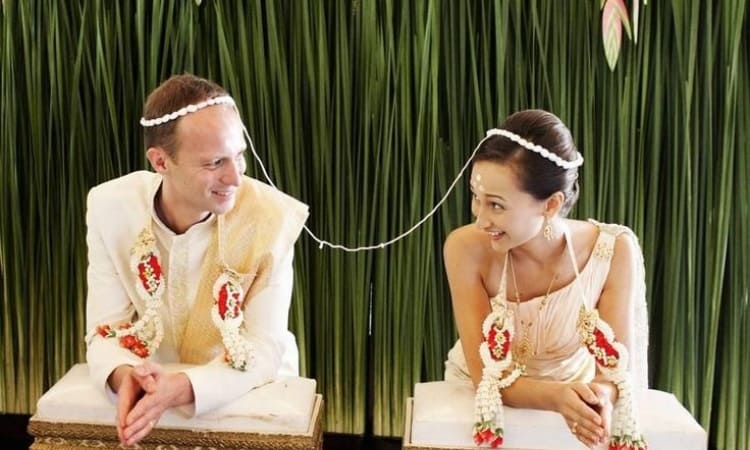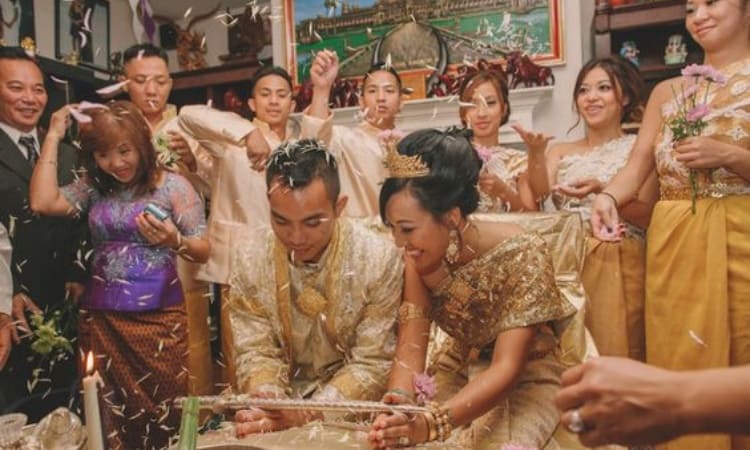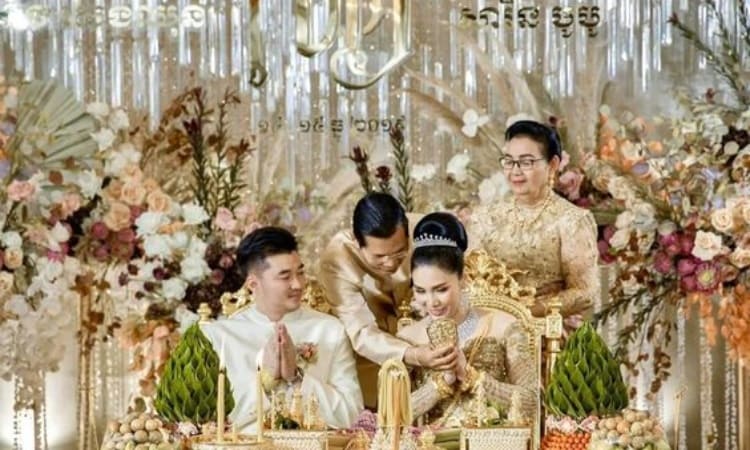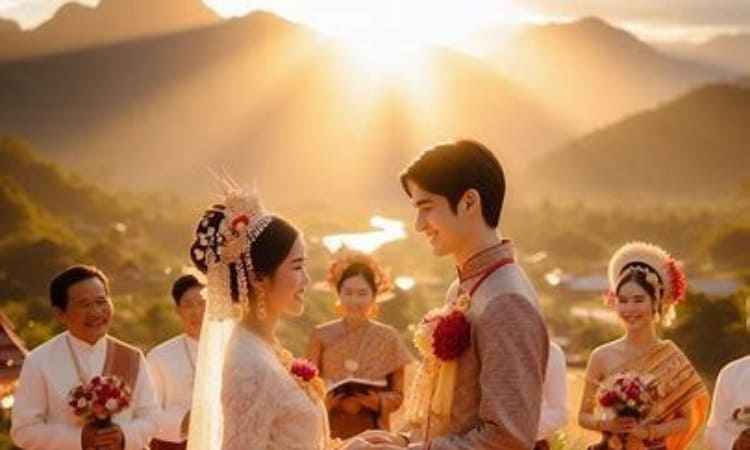I’ve never quite gotten over the romance and charm of Thai wedding traditions. I’ve attended a total of three celebrations, and each one was as enchanting as the last.
What surprises me the most in Thai traditional wedding ceremonies is the sheer number of steps it has. Some wedding ceremonies take days if not weeks! It starts with accumulating good karma through various deeds and transitions to colorful parades and gift-giving. And that’s just the beginning!
If you’ve been invited to a Thai wedding or recently gotten engaged to a Thai partner, there are a few wedding customs you should be aware of. Thai weddings usually involve the following rituals:
1. Making Merit
Thailand practices and promotes Buddhism, with more than 92% of the population adhering to the faith. As a result, Buddhist rituals and traditions play a significant role in Thai weddings.
Among this tradition is making merit, also known as “tam boon.” It involves performing acts of generosity, kindness, and good deeds days before the wedding to foster positive karma in the couple’s marriage.
There are multiple ways to make merit.
One of the most common practices involves offering food, necessities (household supplies, toiletries, robes, etc.), or money to Buddhist monks.
Upon accepting the offerings, the monks chant sacred verses to bless the couple with good fortune, happiness, and a long-lasting marriage.
The couple then bows respectfully, offering their prayers and thanks in return. This ceremony is believed to bring the couple good luck and ensure a prosperous and harmonious marriage.
Another common way to make merit is to grant an animal its freedom, like releasing a bird from a cage or a fish or turtle back into the water.
Acts of generosity, such as helping those in need or supporting charitable causes, are likewise considered a way to accumulate merit.

Image source: Pinterest
2. Receiving Monks’ Blessings
On the morning of the wedding, the couple invites an odd number of monks, usually five, seven, or nine, to the venue.
In Buddhist traditions, odd numbers are considered auspicious. The higher the number, the greater the blessing. Nine is often considered the luckiest odd number, so most couples invite nine monks for their blessing.
The couple offers the monks food, serving them while holding a rice ladle together. The person whose hand is placed above the other takes the role of the “leader” in the relationship, which is usually the bride. No one else is allowed to eat until the monks complete their meal.
After eating their fill, the monks perform a Buddhist blessing ceremony where they chant sacred verses and anoint the foreheads of the groom and bride. The monks also bless a pot of water that will later be used in another ceremony. Blessing the water turns it into holy water.
3. Khan Maak Parade
Though not as commonly practiced today as it was in the past, Khan Maak is still considered a sacred practice in some regions of Thailand.
Khan Maak is a traditional procession in which the groom leads a Khan Maak parade (consisting of his friends and family) to the bride’s home, bearing various gifts.
These gifts include sweets, fruits, gold, silver, and other items that symbolize love, fertility, prosperity, and longevity in Thai culture.
The procession is bright and cheerful, with the groom’s friends and family singing and dancing to the beats of traditional long drums. They’re also dressed in traditional Thai costumes.
Upon arriving at the bride’s house, the groom and his entourage would be blocked by symbolic gates. These gates, called “pratoo ngoen” (silver gate) or “pratoo tong” (gold gate), are silver or gold chains held by the bride’s female friends and relatives.
To get through the gates, the groom or a respected senior must offer envelopes of money to the gatekeepers.
Sometimes, the gatekeepers would give the groom a hard time and ask him to complete a harmless task, like telling them a funny joke or singing a song. This door games session is called “Sanuk.”
4. Proposing To the Bride
Once the groom successfully passes through the gates, he’s welcomed to the bride’s home. Inside, he’s greeted by the bride’s family and offered refreshments as a gesture of hospitality.
The groom’s parents or guardians introduce themselves to the bride’s parents and propose to the bride on the groom’s behalf. The groom’s friends and family then present the dowry he’s brought and prepared.
The bride’s family goes through the dowry, sprinkling the offerings with grains, flowers, and popped rice as they do. Upon deeming it sufficient, the couple exchanges engagement rings.
Nowadays, this ceremony is more symbolic than anything else. Usually, the bride’s parents return the dowry after the wedding to help the couple with their married life.
This ceremony can take place days before the wedding, though some modern couples choose to do it on the morning of the wedding.

Image source: Pinterest
5. Tying of White Thread
Following the engagement ceremony, the couple partakes in a “Sai Monkhon” ritual.
In this ritual, an elder ties a white thread around the couple’s heads, linking them together in two separate circles. These circles are known as the “Circles of Luck,” symbolizing that although they’re united, their individual identities remain intact.
Relatives will then tie white strings around the couple’s wrists as a form of good luck. This string will remain around the couple’s wrists for at least three days.
6. Pouring of Holy Water
The holy water ceremony is another important marriage tradition in Thailand. Usually, this ritual is performed right after the tying of the white thread.
During this ceremony, the bride and groom kneel before their elders, with the bride sitting to the left of the groom.
An elder—usually a parent, grandparent, or respected relative—pours water blessed by monks over the couple’s rope-bound hands. The water is poured through a conch shell.
As the couple’s hands are soaked in holy water, the elder offers a few words of blessing and good luck. Parents, close friends, and selected guests follow suit, also soaking the newlyweds’ hands with the holy-water-filled conch.
This ceremony is known as “Rod Nam Sang,” or the Conch Shell Blessing. It starts in the afternoon and continues until dinnertime.
7. Evening Proceedings
As the night goes on, the host invites the groom’s friends and family to present the newlywed couple with a floral garland called “Phuang Malai.” The garlands are draped around the bride and groom’s neck.
Afterward, the host asks family and friends to share a toast of congratulations, much like what you’d do in a Western wedding.
A long night of drinking and dancing follows. When the wedding cake is cut, the bride and groom serve their parents and seniors first as a sign of respect.

Image source: Pinterest
8. Bedding Ceremony
The bedding marriage ceremony in Thailand is another relatively outdated ritual, but it’s still commonly practiced in rural areas.
In this ceremony, newlyweds are escorted to the bedroom after the celebration. Inside, an old married couple is sitting on the bed, waiting to greet the duo.
The old couple symbolizes a long and successful marriage, and their presence is believed to bring blessings of happiness and prosperity to the newlyweds.
The bed is decorated with flowers, bags of rice, and coins, acting as tokens of fertility and prosperity. The couple is expected to share their bed with these objects for the next three nights.
The old couple leaves after a few words of good luck, and the Thai wedding ceremony concludes.
Final Thoughts
Wedding customs in Thailand are as sacred as religion. They’re rooted in tradition and symbolism, reflecting the values of love, respect, and harmony.
If you’re visiting a Thai wedding, especially as a close friend or family member, make sure to participate in the customs with respect and reverence. Don’t hesitate to ask the couple or their family members for guidance if you’re unsure of Thai wedding traditions.







